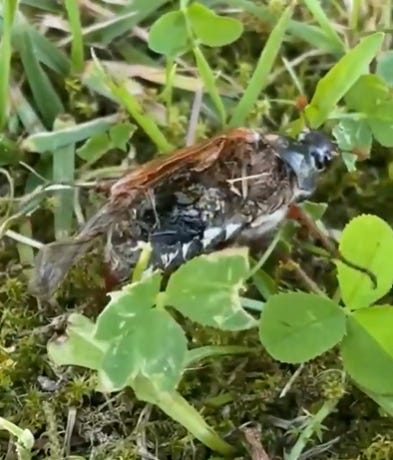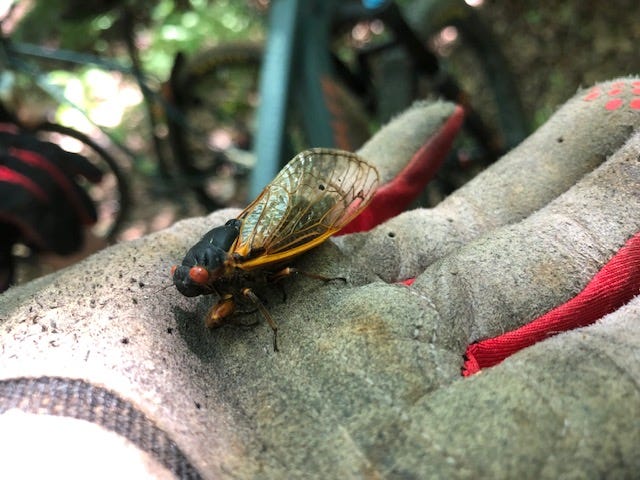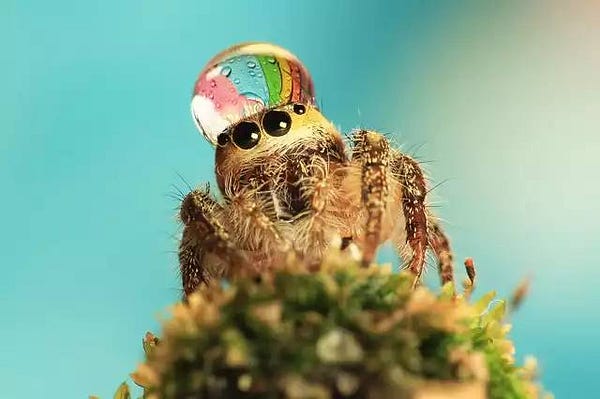Welcome to Natural Wonders! I hope, if you’re in the northern hemisphere, that you’ve been able to enjoy the fall season and all the beautiful colors, blue skies, and campfire weather that usually comes with it. The leaves are crunching underfoot and I feel guilty any time I’m stuck inside instead of wandering around the woods before they go to sleep for the winter…
In honor of the upcoming Halloween holiday, this issue is the second in the Creepy Critters edition: last week I shared shovel-headed worms and their resemblance to Dracula, and today I’ll talk about… Zombie Bugs!
Imagine you’re an ant, minding your own business as you crawl about the forest floor, when suddenly an enormous insect 20 times your size lumbers into view. It’s a cicada, which is not all that unusual to see, except that this one is mindlessly walking rather than flying. You scurry out of its way, but it doesn’t even seem to notice you. As it passes you by, you see that its wings are useless stubs and its abdomen is a hollowed-out hole. It’s not dead, but it’s not alive, either. And yet it’s walking:
The Walking Dead, Insect Edition
It turns out that there are a surprising number of instances of zombification in the insect world, oftentimes due to pathogenic fungi.
Cicadas
Here in the southern United States, the heat of summer is punctuated by the whirring buzz of cicadas echoing from the treetops. But every 17 years, a massive explosion of cicadas occurs as a special crop of cicadas known as Brood X crawl out of their holes in the ground to eat, breed, and metamorphize before crawling back into the ground to hibernate for another 17 years. The last invasion occurred in 2021, when we found this red-eyed example in northern Georgia:
Fortunately, it wasn’t infected with the zombifying fungus but if it had been, we’d have noticed that its body would be filled with fungal spores that disintegrated its insides:
Even though it makes the bugs become sterile, the fungus acts like a sexually transmitted disease and makes them incredibly eager to mate with other cicadas in order to spread the fungal spores as far and wide as possible. The fungus takes over the cicadas’ brains so all they can think about is mating – males even begin to engage in female courting rituals, essentially taking on Drag Queen characteristics so they can attract as many mates as possible of either sex. It’s a virtual Studio 54 psychedelic party.
Including the drugs.
Scientists have discovered the fungal masses in the cicadas’ abdomens contain psylocibin and cathinone, both of which are schedule 1 drugs regulated by the DEA! Psylocibin is the drug found in psychedelic mushrooms and can ease depression in humans, while cathinone is usually found in East African plants and increases concentration for people with ADHD. It’s possible these drugs are what make it possible for the cicadas to push through the disorientation (and pain?) caused by half their bodies missing to continue mating.
These insects are basically hollowed-out zombies who can only think of one thing – mating – because they’re hyped up on shrooms.
Wormy Crickets
Another example of zombification occurs with European crickets who become infested by horsehair worms.
Horsehair worms mate in bodies of water and then lay their eggs on the nearby banks. Crickets wander by and ingest the eggs, which hatch inside them. The horsehair worms are aptly named – they are long and extremely thin. After they hatch inside the cricket, they grow to their full 5-inch length before somehow (scientists aren’t clear quite how they do this) zombifying the cricket and taking over its mind. The cricket, who usually likes dark, dank places, will instead crawl out into the sun, find a body of water, and jump in, basically committing suicide so that the horsehair worm nematode can escape and find a mate.
Disco Worms
In this freaky zombie iteration, the parasitic worm Leucochloridium invades snails, then crawls up to their eye sockets and pulsates to imitate a caterpillar. The snail becomes blind and no longer has control over its eyes.

The worm lurking inside hopes to attract a bird to eat the pulsing eyes so that it can release eggs in the bird’s gut, which will be released in its feces to start the process all over again. Since the amber snail this worm invades is typically nocturnal, the worm takes over its mind and forces it out into the light of day. The zombified snails are also much faster than typical snails, practically racing along at 3 feet every 15 minutes.
The only good news is that once the snails have their eyes plucked out by a hungry bird, the parasitic worm is gone and the snail usually regenerates its eyes and recovers.
Zombie Ants
I’ve written before about ants that brainwash the larva of their enemies to enslave them. Those are brainwashed, but not zombified ants – there’s a difference.
In tropical forests on many continents (including Florida and South Carolina in the U.S.), there’s a type of carpenter ant that spends most of its life high in the canopy of the forest, though occasionally it travels down to the forest floor to move to another tree. That’s when the fungus Ophiocordyceps metaphorically pounces by attaching itself to the ant and traveling to its brain. The ant, which has begun to climb back up to the tree canopy, has a brain seizure and falls to the ground where it comes completely under the control of the fungus. No longer in control of its own body, the ant searches for the perfect environment for the fungus to survive, then latches onto a plant with its powerful jaws and promptly dies. Its body serves as a spore factory for the fungus and after a week or two, new spores erupt from the ant’s dead carcass, infecting other nearby ants.
Believe it or not, these are just a few of the disturbing number of examples I found of zombification in the insect world. What do you think? Should we be worried about an upcoming Insect Zombie Apocalypse?
Weird Nature
As if the information above wasn’t weird enough…
Detritus
Why it’s perfectly normal to see baby puffins thrown off cliffs in Iceland every year.
Not into psychedelic mushrooms? Perhaps the toxic death cap mushroom invading lawns in the western U.S. is more your style.
Or perhaps you’d like to use mushrooms to rapidly decompose your shingles?
If you liked this issue, please click the “like” button below - it makes me happy and also raises the profile of this newsletter!













*sits in silence for a while*
BLOODY HELL.
.....
*sits silently for a while longer*
This is good content but I don’t want to share it and ruin somebody’s day.